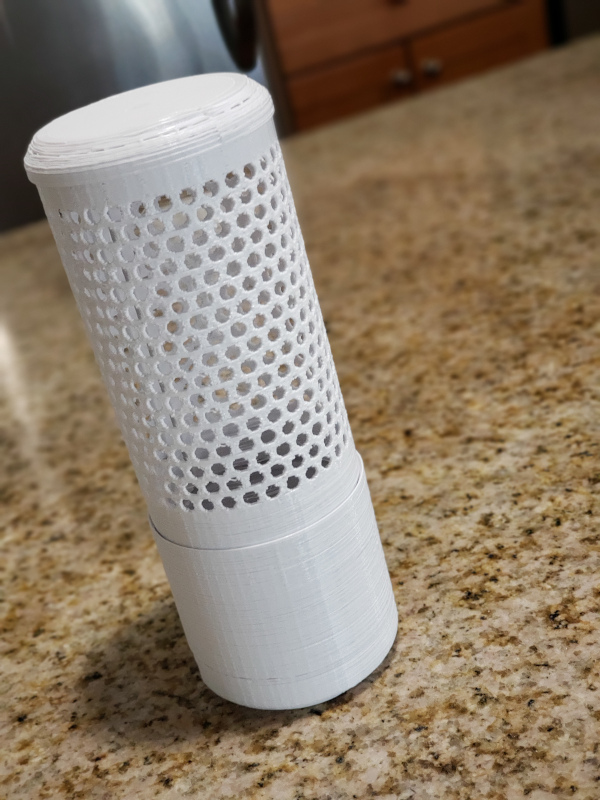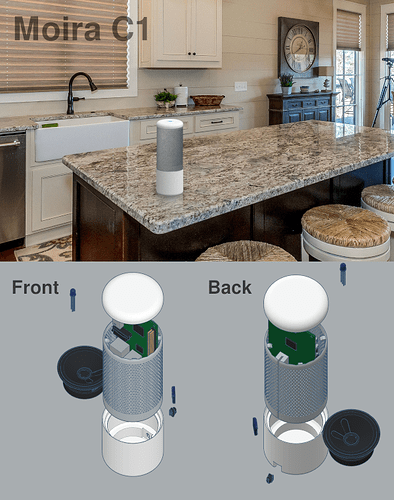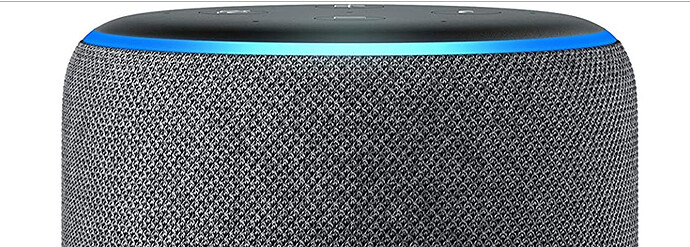Wow, thanks for all the feedback! There is some super-helpful stuff in here.
@malevolent
do the microphones work well when they are placed upon the speaker? I mean, can the user speak to the C1 when there is sound? I guess ReSpeaker has noise cancelation, but just wondering.
That is a very good question. See below. 
LED light is just a dot? it would be great if it would were a “line” on the border around the top and/or bottom of the speaker, a la Alexa ( I like their design of that light)
It is just a single LED (for now). I’m trying to make this design simple for the community to print and assemble at home, but aRBG is something I’ve considered.
Hardware buttons, don’t see any, but what about 4: power, vol +, vol - and play|pause . Buttons should be placed on top and be part of the enclosure, without standing out from it.
See below on this one, too!
Dark color option! I found black more elegant and “clean” than white or clear colors
This will be completely up to the user. I don’t currently plan to distribute this, just to provide it to the community. If there is enough interest I would investigate a group-buy of professionally printed parts, though.
@J_Montgomery_Mycroft
Can you drop STLs here so we can take a peek?
I would love to get some feedback from you since you’ve been so intimately familiar with designing these things, but I’m rather enjoying designing on my own without influence from a whole bunch of people so I can continue to learn  Would you be OK if I DM them directly to you?
Would you be OK if I DM them directly to you?
The power needs to be extremely clean and grounding needs to be well thought out or the speaker will buzz.
Do you have any specific suggestions here?
The mic and speaker should be in physically separated.
…
Noise canceling mic arrays need to be co-planer. They don’t work as designed under a dome.
Hrm, this may require a redesign of sorts to make things wider then. The second item also seems like two separate ideas. So you’re saying I need to lay the mic array flat (co-planar) but also don’t put it underneath the lid (dome)? Just trying to follow the thought process.
The Re-Speaker stuff makes us of a proprietary binary for noise cancellation. This may or may not work with the 2 mic setup ( I don’t know because I haven’t tested ).
Is there another hardware suggestion you would recommend?
The grill can be printed with FDM, but it is very hard to get it right. The retract on the FDM can cause issues with alignment and make prints difficult.
The “printed” grill is really a frame to wrap in speaker cloth. It’s a tiny bit narrower than the top and bottom which overlap the edges. It’s also why there is a gap across the back, to make it easier for assemblers to pull the cloth inside the cylinder and then attach it. I’ve actually already redesigned that some to simplify construction (removing the need for supports) and make the holes bigger.
Making textiles work on a plastic speaker is more difficult than you might think.
I’ve done a lot of speaker design/construction in the past (I’ve designed crossovers that were balanced flat for a room/etc) however this will be my first time laying cloth onto plastic. I am also curious how this will go, but I think I’ve got a working idea with the pull-through attachment method.
Heat. Pay attention to how air gets in/out of the microprocessor chamber.
This was why I put the Pi inside the speaker cloth area. I’m hoping there will be enough ventilation that way.
Hardware buttons are important. Precise works…(ish)…but in a loud enviroment it may become impossible to control the speaker which leads people to unplug it…which corrupts the CF…which bricks it until it is re-flashed.
Yea, 2 votes already for hardware buttons. This is something that I’ll certainly find a way to implement, but maybe in v2.0 so I can get this thing out to the world more quickly. I started to look into capaciive buttons that I could lay under cloth like how the Google Home Mini works.
The timing between the wake word detection and dropping the volume via the Adafruit amp can be a problem.
Good to know. Same question as above, any hardware suggestion?
We had a meeting about getting people in the community more involved in the hardware ( and software ) development process. More news on this to come, but…yes…we are going to start involving the community more in both the decision making and implementation.
I don’t want to hijack this thread tho, so we’ll have that discussion in a new thread soon.
Please post a link in here when it comes so we (I) can find it 
On a good note, the test print (rough) came out as expected:



